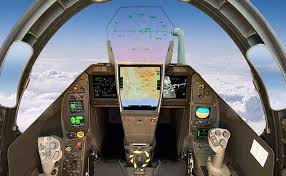What Rafale brings to India: A Review
What Rafale brings to India: A Review
By: Kartikeya Semwal
Introduction:
The much awaited 5th generation Rafale Fighter deal is about to be closed. French firm Dassault Aviation has decide to sell the aircraft to India at close to $250 million/fighter against the previous price of $300 million/fighter.
Rafale's Cockpit:
The cockpit has hands-on throttle and stick control (HOTAS) and is equipped with a heads-up, wide-angle holographic display from Thales Avionique, which provides aircraft control data, mission data and firing cues. With a collimated, multi-image head-level display that presents tactical situation and sensor data, while two touch-screen lateral displays show the aircraft system parameters and mission data. The pilot also has a helmet-mounted sight and display. A CCD camera and an on-board recorder records the image of the head-up display throughout the mission.
Rafale's weapons:
Rafale can carry payloads of more than 9 ton on 14 hard-points for the air force version, with 13 for the naval version. The range of weapons includes: Mica, Magic, Sidewinder, ASRAAM and AMRAAM air-to-air missiles; Apache, AS30L, ALARM, HARM, Maverick and PGM100 air-to-ground missiles and Exocet / AM39, Penguin 3 and Harpoon anti-ship missiles.
For a strategic mission the Rafale can deliver the MBDA (formerly Aerospatiale) ASMP stand-off nuclear missile.
The Rafale also carries Sagem AASM precision-guided bomb, which has both GPS / inertial guidance and, optionally, imaging infrared terminal guidance. Rafale has been equipped with the AASM since 2008. Rafale can carry six AASM missiles, with each aiming to hit the target with 10 meters accuracy.
The Rafale has a twin gun pod and a Nexter (formerly Giat) 30mm DEFA 791B cannon, which can fire 2,500 rounds a minute. The Rafale is equipped with laser designation pods for laser guidance of air-to-ground missiles.
Countermeasure & sensor technology on the twin-jet combat aircraft
Rafale's electronic warfare system is the Spectra from Thales. Spectra incorporates solid state transmitter technology, a DAL laser warning receiver, missile warning, detection systems and jammers.
The Rafale is equipped with an RBE2 passive electronically scanned radar developed by Thales, which has look-down and shoot-down capabilities. The radar can track up to eight targets simultaneously and provides threat identification and prioritization.
Thales developed an active electronically scanned version of the RBE2 and equipped the Rafale with it in February 2011. Flight tests of the radar on-board the Rafale took place in 2008.
RUAG Aviation has been awarded a $5 million contract by Thales in May 2009 to produce sub assemblies for the RBE2 radar to be equipped on the Rafale fighter jet.
Optronic systems include the Thales / SAGEM OSF infrared search and track system, installed in the nose of the aircraft. The optronic suite carries out search, target identification, telemetry and automatic target discrimination and tracking.
In January 2012, the French Ministry of Defence awarded a ten-year contract to Thales to maintain the electronic systems and warfare of the aircraft.
Navigation & communication systems of Rafale
The communications suite on the Rafale uses the Saturn on-board V/UHF radio, which is a second-generation, anti-jam tactical UHF radio for NATO. Saturn provides voice encryption in fast-frequency hopping mode.
The aircraft is also equipped with fixed-frequency VHF / UHF radio for communications with civil air traffic control. A multi-function information distribution system (MIDS) terminal provides secure, high-data-rate tactical data exchange with NATO C2 stations, AWACS aircraft or naval ships.
The Rafale is powered by two M88-2 engines, each providing a thrust of 75 kN.
Rafale is equipped with a Thales TLS 2000 navigation receiver, which is used for the approach phase of flight. TLS 2000 integrates the instrument landing system (ILS), microwave landing system (MLS) and VHF omni-directional radio-ranger (VOR) and marker functions.
The radar altimeter is the AHV 17 altimeter from Thales, which is suitable for very low flight. The Rafale has a TACAN tactical air navigation receiver for en-route navigation and as a landing aid. The Rafale has an SB25A combined interrogator-transponder developed by Thales. The SB25A is the first IFF using electronic scanning technology.
The engines that power Rafale
The Rafale is powered by two M88-2 engines from SNECMA, each providing a thrust of 75 kN. The aircraft is equipped for buddy-buddy refueling with a flight refueling hose reel and drogue pack. The first M88 engine was delivered in 1996. It is a twin-shaft bypass turbofan engine principally suitable for low-altitude penetration and high-altitude interception missions.
The M88 incorporates the latest technologies such as single-piece bladed compressor disks (blisks), an on-polluting combustion chamber, single-crystal high-pressure turbine blades, powder metallurgy disks, ceramic coatings and composite materials.
The M88 engine comprises a three-stage LP compressor with inlet guide vane, an annular combustion chamber, single-stage cooled HP turbine, single-stage cooled LP turbine, radial A/B chamber, variable-section convergent flap-type nozzle and full authority digital engine control (FADEC).
Messier-Dowty provides 'jumper' landing gear, designed to spring-out when the aircraft is catapulted by the nose gear strut.
With all such capabilities, Rafale is a complete 4.5 generation fighter that will suite iaf (Indian Air Force) requirements pretty well, giving it an edge against its enemies.





Comments
Post a Comment